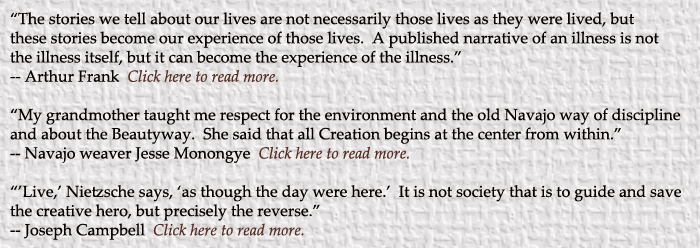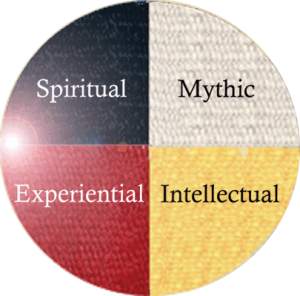
 We use the term “myth” to refer to stories that express important Truths held by an entire culture or people. Mythic ways of knowing about the world and ourselves are expressed in art, music, story, and dream. Their richness both arises from and reaches into our deepest selves, to express and also shape who we are as living beings in a particular place and time.
We use the term “myth” to refer to stories that express important Truths held by an entire culture or people. Mythic ways of knowing about the world and ourselves are expressed in art, music, story, and dream. Their richness both arises from and reaches into our deepest selves, to express and also shape who we are as living beings in a particular place and time.
Many scholars who have studied myths, including Joseph Campbell, Clarissa Pinkola Estes, and Carl Jung, feel that the most important myths are universal — that they express basic Truths held by many if not all human beings, in many time periods and places. They explain this universality in several major ways, all of them keyed to a universality of human biology, history, and consciousness.
To Indigenous peoples, the common ground that produces the powerful symbols of myth and art is more than a collective human experience. Such myths or stories are universal because they emerge from the very fabric of the Earth itself, rising from its stones and soils the same way living things do. In this world view, art and story are real rather than representative, and the components referred to as “symbols” or “metaphors” by Western culture are instead parts of an actual whole.
Both cultural views of myth are powerful, though significantly different. In contemporary Modern worldview, reflecting on the myths we tell in image, film, music, and poetry allows us to catch sight of the deep-seated things our cultures hold to be True. They give us the power to evaluate the myth and decide whether or not we actually believe it. As society changes, its ideals and concepts of right and wrong change — and the myths are overturned or reformed as society explores new images and stories that tell the new Truths.
In the Indigenous worldview that guides Tapestry, where mythic stories are told by the natural world as a fundamental aspect of its existence, human beings participate in the on-going story being told through the lives they live. So in this worldview, mythic level art and story do not simply tell us about our culture and its beliefs, but instead help create and maintain a whole and healthy Reality.
To explore an example of Mythic Ways of Knowing first-hand, visit Mythic Ways of Learning about Tornadoes.
To proceed around the Circle of Ways of Knowing, visit Integrated Ways of Learning and Knowing.
To proceed around the Circle to the next direction, visit the Center.
You may use the table below to explore the directions, their associated ways of knowing and learning, and an example of each type of learning as applied to understanding tornadoes.
